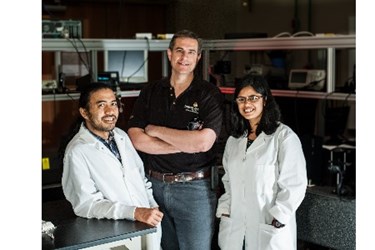Scientists Invent New Way To Control Light

Discovery Could Prove Critical for the Next Generation of Super Computing
A device resembling a plastic honeycomb - yet infinitely smaller than a bee’s stinger - can steer light beams around tighter curves than ever before possible, while keeping the integrity and intensity of the beam intact.
The work, conducted by researchers at the University of Texas El Paso (UTEP) and at the University of Central Florida (UCF), was recently published in the journal, Optics Express. The discovery introduces a more effective way to transmit data rapidly on electronic circuit boards by using light. Microchip and computer manufacturers are increasingly looking at light to overcome speed bottlenecks associated with today’s electronics.
Sending information on light beams, instead of electrical signals, allows data to be transmitted thousands of times more quickly. However, controlling the light beams without losing their energy has posed many challenges.
“Computer chips and circuit boards have metal wire connections within them that transport data signals,” said Raymond Rumpf, professor of electrical and computer engineering at UTEP. “One of challenges when using light is figuring out a way to make tight bends so we can replace the metal wiring more effectively.”
This is where UCF has played an integral role in finding a solution.
“Direct laser writing has the potential to become a flexible means for manufacturing next-generation computer devices,” said Stephen Kuebler, associate professor of chemistry at UCF.
Kuebler and his students used direct laser writing, a kind of nanoscale 3D printing, to create the miniature lattices. The team then ran light beams through the lattices and confirmed that they could flow light without loss through turns that are twice as tight as any previous attempts.
The finding is significant because with the demand for ever-smaller and faster computers and hand-held devices, engineers need ways to pack ultra-fast data-transmission devices into smaller spaces. Conventional light waveguides, like optical fibers, can be used to steer light through turns, but the turns must be gradual. If the turn is too quick, the light beams escape and energy is lost. The team designed the plastic devices so that its lattice steers the beam around corners without losing energy, which are ideal for ultra-sharp turns.
The UTEP-UCF team’s technology creates a new record in the field of optics for its ability to bend light beams. Kuebler said the team is now working to double that record, creating a lattice that will turn the light through an even tighter turn.
Rumpf, who runs UTEP’s Electromagnetic Lab, envisions this groundbreaking technology will first appear in high-performance super computers before it can be found in people’s everyday laptops.
About University of Central Florida
The University of Central Florida (UCF), the nation’s second-largest university with nearly 60,000 students, has grown in size, quality, diversity and reputation in its first 50 years. Today, the university offers more than 200 degree programs at its main campus in Orlando and more than a dozen other locations. UCF is an economic engine attracting and supporting industries vital to the region’s future while providing students with real-world experiences that help them succeed after graduation. UCF's research & commercialization enterprise is fueled by more than $1B in funding over the last decade and is ranked among the top 25 universities in the world for patent production. For more information, visit www.research.ucf.edu
Source: University of Central Florida
